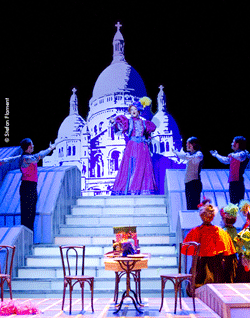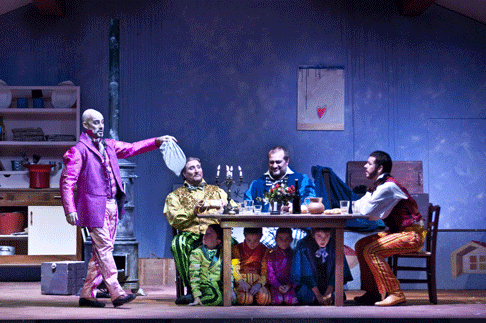27 Jan 2012
La Bohème in Toulon, Marseille and Genoa
Three La Bohèmes in ten days, a critic’s nightmare that was more fun than a barrel of monkeys.

Three La Bohèmes in ten days, a critic’s nightmare that was more fun than a barrel of monkeys.
Well, why not? Why not make La Bohème about 1968! 1968 was a long time ago, dim in memory but now that you mention it an exciting time to recall — the vehement anti-Vietnam war protests in the U.S. were small in comparison to Mai 1968, huge protests in Paris and around France against authority (any and all), a premise wildly cheered by American and Italian university students eager for any and all revolution, all this general excitement notably prompted by the politically pointed 1968 Prague Spring.
Maybe May 1968 is a mantle that La Bohème does not wear very well. But never mind, it was fun to revisit those exciting times even if the 2003 Nice Opera production by Daniel Benoin revived just now in Toulon was filled with much imagery that was maybe recognizable only by the French, and by now those French of a certain age (this seems to have been the case based on overhearing intermission conversations). It did leave us Berkeley-ites of a certain age mostly in the dark.
A bit of post-performance research into Mai 1968 explained that the rubber face-masked, caricatured Maoists who marched in at the end of Act II were deriding the French communists who joined the rightwing Gaullists to condemn the strikes. Riot police were everywhere in Mai 1968 (DeGualle had fled to Germany) thus they prefaced the third act by climbing onto the stage to be in place before the curtain rose onto a mesh fence with a gate that guarded some sort of internment compound and then inexplicably did not.
Mr. Benoin, director of the esteemed Théâtre National de Nice since 2002, is not a musical opera director, if he were musical he would know that you better not mess around with La Bohème at all. He would know that posters announcing the appearance of Country Joe and the Fish at the Café Momus would disqualify Puccini’s orchestra, that Musetta, a determined, militant revolutionary, could not croon her waltz into a microphone to a mute jazz trio accompaniment. He would know that if a corps de ballet did happen by the Café Momus it would not attempt to jive dance to Puccini’s trumpet fanfares.
But make no mistake, Mr. Benoin is a savvy director (making one curious if a little nervous about the Madame Butterfly he staged in Salerno [Italy] in 2007). He used his Act III wire mesh fence to sublime effect, separating his sets of lovers while allowing them to touch. His Act IV conceit was to clothe his entire cast in pure white, Rodolfo draping the windows with white cloth at the moment Mimi expired. All this packed a wallop.
If Daniel Benoin indulged himself in seemingly arbitrary forays into high theatrical style Toulon Opera music director Giuliano Carella indulged Puccini in some very powerful verismo that exactly magnified the opera’s emotive intent to huge proportion, real and pure embodiment of the verismo ideal of oversized sentiment. This an accomplishment rarely achieved on any operatic stage. Well, once we got to Act III that is. Acts I and II were rocky, evoking terrors that are usually dealt with at the dress rehearsal. And the maestro simply could not drag the Toulon chorus into a festive melée at the Café Momus.
Finally La Bohème rests on the charm and voice of its bohemians, and Toulon Opera did not let us down. The Bohème herself was Italian soubrette Nuccia Focile whose mannered Italian endowed Mimi with more personality than we may have wanted but whose voice rose to easy highs to insinuate a younger and simpler idea of this heroine. Sympathetic Polish tenor Arnold Rutkowski, easily the audience favorite, drew his musical lines with more than usual ease suggesting that Onegin’s Lenski is his innate character. Georgian born French soprano Anna Kasyan brought good, tough character to this unusual Musetta though she only sometimes seemed to have the requisite vocal heft. Italian baritone Devid Cecconi was a gruff, lovable, bumbling Marcello aided by countrymen Massimiliano Gagliardo and Roberto Tagliavini as the charming and vocally adept Schaunard and Colline.
Trailer for Toulon production of La Bohème
Well, why not translocate La Bohème onto the rooftops of Paris, maybe like a movie musical (Moulin Rouge for example)? These rooftops rarely have people on them for good reason (they are steep) so the trick just now in Marseille was finding a few flat places where bohemians could frolic and die.
Rooftops are just that so there was no way to sketch an artists’ garret, a café or an entrance to the city, after all these places are easily imagined. Maybe this lone rooftop location was a bow to the new austerity that has made opera companies worldwide feel as penniless as Puccini’s bohemians.
La Bohème is indestructible, or nearly. The holiday season Bohème at Marseille Opera toyed with that distinction. This Christmas Eve bonbon (well, the first two acts) might have survived the rooftop concept but it could not survive the attempt to turn Puccini’s thrusting emotions into the measured, percolated, precious movements of spirit that mark a Britten or Janacek opera. Like a driver willfully blocking the flow of traffic by driving too slowly to prove how careful he is, Irish conductor Mark Shanahan thwarted the very essence of verismo by rendering it into slow, almost frozen musical motion. The cathartic moment of Puccini’s tearjerker in Marseille finally was not a tear or two, it was pure and simple road rage at the conductor.
Were it not victim of the conducting this La Bohème probably would have succumbed at the moment Musetta’s waltz became a 1950’s movie musical production number, those Parisian rooftops disguised very symmetrical platforming that allowed a garishly costumed Musetta, let us say clownishly, to top a pyramid of snazzy Café Momus waiters executing some snappy choreography. Well, Café Momus was already a crazed showbiz, dayglo colored adult playground so why not.
It would be unfair to delve too deeply into the individual performances as there was obvious dissension between pit and stage, and not just between the singers and the conductor, also between stage management and conductor — changes in the lighting seldom occurred at the appropriate musical moment.
 Promotional photo of Marseille production of La Bohème
Promotional photo of Marseille production of La Bohème
Suffice to say that French soprano Nathalie Manfrino was a vocally and physically attractive Mimi, though her ample sound was mismatched to Ricardo Bernal as the young, handsome Rodolfo. This Mexican tenor’s appropriately Italianate delivery was hampered by a voice more suited to the light lyric roles. Marcello, Schaunard and Colline were undertaken by Marc Barrard, Igor Gnidii and Nicolas Courjal respectively. All are accomplished in their roles though none found the youthful charisma of their characters as had the Mimi and Rodolfo.
The staging concept credited to Jean-Louis Pichon seems to have been to transform Puccini’s sad little tale into a slick musical with one nifty crowd scene, leaving the well known tunes elsewhere to fend for themselves as well they might and usually do. Marseille’s remarkable opera house, unequaled anywhere for its direct stage-audience rapport did respond from time to time to the obtuse staging with some enjoyable stage pictures.
Well why not? Why not place Puccini’s sad, gritty little story in an enchanted storybook world where fantastically dressed bohemians named Mimi, Rodolfo, Marcello, Schaunard and Colline have identically fantastically dressed child counterparts aged 5 to 9 who mirror their every move.
There was no message in Genoa just now, like innocence is transitory if not illusionary — “just wait until you grow up, kids, life gets complicated.” Instead it was simply the bi-polar Bohème pathology gone extreme. The first two acts of the opera are indeed childish play, as are the antics of the fourth act, and you know the rest of the story.
The juxtaposition of storybook and real seemed ridiculous but once you thought about it, well, thought about it quite a lot, you could make it make some sense. It was a justifiably abstracted bi-polar world that incorporated Puccini’s verismo, if uncomfortably, by separating the visual and sonic worlds. The musical was what is real, even tangible (like great verismo really is), and the visual became a metaphysical world that shadows and colors the real, like music ordinarily does (yes, this conclusion took some thinking).
So we were very much on edge, and maybe heard this great masterpiece with new ears, as we were seeing it with new eyes. There were other advantages that we will get to.
 Scene from Genoa production of La Bohème [Photo by J. Morando]
Scene from Genoa production of La Bohème [Photo by J. Morando]
Teatro Carlo Felice invited Genoa born and culturally nurtured artist Francesco Musante to create this new production. Over his long career Mr. Musante has exploited op art and Viennese Succession influences, he has worked in water color, lithograph and particularly illustration. A specific reference in his oeuvre to this telling of La Bohème might be his comic book rendition of Lewis Carrol’s Alice in Wonderland (1980). Mr. Musante is not widely known outside Italy.
The Musante abbozzi, or renderings of the scenes displayed in the foyer of the opera house succinctly expounded the artist’s specific vision of La Bohème — a bright and noisy world animated by children. Act II was in fact an illustrated music box merry-go-round wound up by the children on the stage at the end of Act I.
On the Carlo Felice stage Mr. Musante’s sketches were made live by Italian actor Augusto Fornari who presumably was in cahoots with the artist. This obviously able stage director was hampered by the absence of professional child actors, here the extensive mimicry was supplied by members of the Carlo Felice’s Children’s Chorus (“coro di voci bianchi”). But what a chorus this was! The first in living memory to carry out hyper visual antics in perfect [!] synchronization with the Puccini’s musical antics — among them the entry of a 12 member (maybe more) marching band that capped the Momus act with utter visual and musical delirium.
Unaided by any visual realism whatsoever, conductor Marco Guidarini managed only a restrained verismo that fully supported Puccini’s needs but mostly missed finding a synergy with the stage. If this Bohème’s visual world was exuberant and extravagant, Mo. Guidarini’s Puccinian thrust was careful and by-the-book when it could have been pushed to and even beyond verismo extremes.
Musante’s stylized visual language obliterated the need for singers to look or be bohemians, thus they came in all shapes, ages and sizes but to a man on January 5 they had solid Italian schooling and gave big vocal performances with big mannerisms that might be considered tasteless in more restrained musical cultures. Three casts people its eleven performances over a two month period (into February). On January 5 Massimiliano Pisapia was the Rodolfo, though were it not for his musical postures he might have been singing Siegfried. Amarilli Nizza is an accomplished Tosca and Aida on big stages (Verona, Vienna) so she was hardly a retiring Mimi. Hers was a fully successful, vocally and musically splendid performance. Of special interest as well was the Musetta of Alida Berti whose vocal and presence actually matched the exuberance and innocence of the production, as did the remarkably vivid, full voiced Alcindoro of Fabrizio Beggi.
Michael Milenski